72 yr old Lady eats without pain after 3years
- Home
- 72 yr old Lady eats without pain after 3years
Categories
- Across-Blood Group Kidney Transplantation
- Bariatric Surgery
- Bilateral Total Hip Replacement Surgery
- Brain Aneurysm
- Bypass Surgery
- Cardiology
- COVID-19 Coronavirus
- Delta Ceramic Implant surgery
- Dermatology, Cosmetic Surgery & Hair Transplant
- Diabetology
- Fatal Accident
- Fibroid
- Gastrointestinal & Liver Diseases
- General Health
- Genicular Artery Embolization(GAE)
- Gynaecology & Obstetrics
- Haematology, Haemato-Oncology & Bone Marrow Transplant
- Hip & Leg Surgeries
- Hip Replacement Surgery
- Imaging Science
- Interventional Radiology
- Kidney Transplantation
- Liver Transplant
- Multiple Arterial Blocks
- Multiple Brain Aneurysms
- Nephrology
- Neurology & Neurosciences
- Neurosurgery
- Non-surgical Treatment
- Oncology
- Open Heart Surgery
- Orthopaedics
- Osteoarthritic Knee Pain
- Paraplegia
- Pulmonology & Sleep Medicine
- Radiofrequency Ablation
- Thyroid
- Total Knee Replacement Surgery
- Transfusion Medicine
- Urology
- Vascular & Interventional Radiology
- Vascular Reconstruction Surgery
Tags
ACL knee surgery
Acne
Aneurysm
Angioplasty
Apheresis
Arrhythmia
Back Pain
Blue baby syndrome
Bone Marrow Transplant
Breast Cancer
Cancer
carcinoma
COVID-19
ct scan
Diabetology
Gastroenterology
General Health
Heart Attack
Heart Surgery
Interventional Radiology
Keyhole Surgery
liver care
MIOT
MIOT hospital
MIOT international
Neurology
Obesity
Oncology
Optical Coherence Tomography
pandemic
Parkinsons
Pinhole Surgery
Rehabilitation
Rheumatology
Scoliosis
Seychelles
Spinal Deformity
Spine
Sports Medicine
Stenting
stomach pain
Stroke
Total Knee Replacement
Trauma Care
tumor
Make An Appointment
- MIOT International
4/112, Mount Poonamalle Road Manapakkam, Chennai - 600 089
Tamil Nadu, INDIA - +91 44 42002288, +91 44 22492288
Archives
- October 2024
- September 2024
- June 2024
- March 2024
- September 2023
- August 2023
- July 2023
- June 2023
- May 2023
- April 2023
- March 2023
- December 2022
- October 2022
- September 2022
- July 2022
- May 2022
- December 2021
- November 2021
- October 2021
- September 2021
- August 2021
- January 2021
- December 2020
- November 2020
- October 2020
- August 2020
- July 2020
- June 2020
- May 2020
- April 2020
- January 2020
- October 2019
- July 2019
- June 2019
- May 2019
- April 2019
- March 2019
- January 2019
- December 2018
- October 2018
- August 2018
- June 2018
- March 2018
- February 2018
- January 2018
- December 2017
- November 2017
- October 2017
- September 2015
- April 2015
- February 2015
- January 2015
- December 2014
- November 2014
- September 2014
- May 2014
- April 2014
- February 2014
- December 2013
- November 2013
- September 2013
- August 2013
- July 2013
- June 2013
- May 2013
- April 2013
- March 2013
- February 2013
- January 2013
- December 2012
- November 2012
- October 2012
- April 2012
- For the 1st Time in the World, MIOT International Successfully Performed an “Across-Blood Group Kidney Transplantation” in a recipient with the “Bombay O Blood Group” October 10, 2024
- For the 1st time in South India MIOT’s Experts Used an Advanced Stenting Technique to Successfully Treat a Life-Threatening Large Aneurysm at the Brainstem September 27, 2024
- NO SURGERY. NO SCARS. Find out how Mr. Sukumar regained his lifestyle from Osteoarthritis knee pain June 22, 2024
- Mrs. Vivienne Soundy‘s inspiring journey to freedom from osteoarthritis knee pain without surgery June 22, 2024
- MIOT’s Genicular Artery Embolization relieved my mother’s osteoarthritis knee pain without surgery June 22, 2024
- A 14yr old boy with scoliosis treated successfully at MIOT 6156 January 3, 2018
- Severe Deformity of Foot and Ankle corrected successfully with Ílizarov’s Ring external fixator 5795 March 17, 2018
- Turn the clock back with our Spine Specialists at MIOT International. 5228 June 10, 2018
- Breast cancer can be cured with early detection 5228 April 1, 2015
- A case of Systemic Lupus Erythematosys, mis- diagnosed elsewhere, treated successfully at MIOT 4040 February 15, 2018
© 2025 Healthzine Miotinternational. All rights reserved.

Mrs. Shanti, a 72 year old lady had a history of stomach pain for the past 3 years. She was admitted with complaints of severe abdominal pain on eating 1year ago. The pain was so extreme, that eating had become a curse for her. She survived on very minimal amounts of semi-solid and liquid food which had made her lose a considerable amount of weight.
She was diagnosed to have (mesenteric ischemia) blockages of the two of the three main blood vessels supplying her intestines.
Considering her age she was treated with medicines for 6 months but her pain persisted and she started passing blood in her stools hence she got admitted at MIOT last month.
She was not fit for surgical treatment due to her age and the need for major high risk surgery to treat it. She was referred to our Interventional Radiologist to see if this could be treated by endovascular procedure.
Endovascular surgery is an innovative, less invasive procedure used to treat problems affecting the blood vessels that involves making a small incision near each hip to access the blood vessels.
Patient had a 10cm long standing hardened blockage of the main Superior Mesenteric Artery (SMA) (Fig. 1 & 2) and the chances of successful reopening were slim. But considering her age, pain intensity and blood loss, MIOT Doctors decided to take her up for the interventional procedure.
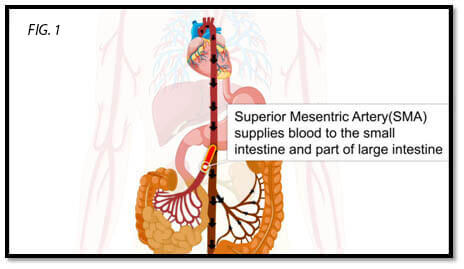
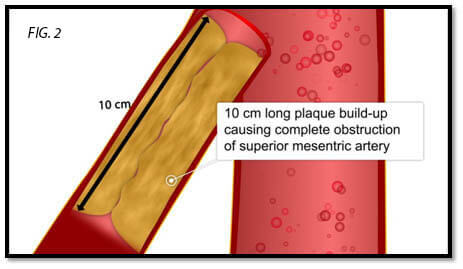
The next day she underwent the surgery in the MIOT’s State-of-the art Biplane Cath lab. As the block was in a very complex position, images were taken simultaneously in 2 projections using the 2 C-arm which was crucial to opening the completely blocked blood vessel in this case. In a machine with a single arm, this would have required the C-arm to be rotated frequently between the 2 required positions, leading to a longer procedure and also the risk of wire getting dislodged from crucial positions when the C-arm is being swung.
Also, with 2 C-arms, only 1 Angiogram is needed as both angulations are captured simultaneously with 1 Contrast dye injection and 1 Radiation exposure, but in conventional Cath lab, 2 Angiograms are needed every time, thus the New Biplane Cath lab reduces the contrast and radiation dose by 50%.
In MIOT’s state-of-the-art Biplane Cath Lab, SMART MASK application overlaps the Angiogram images on live X-ray images, used for live guidance of the catheter.
With the guidance of a SMART MASK application, the interventionist managed to open her blood vessel by slowly crossing the blocked segment (Fig. 3).
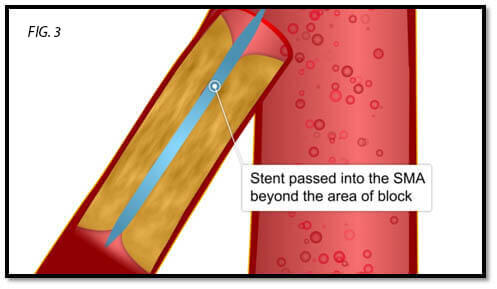
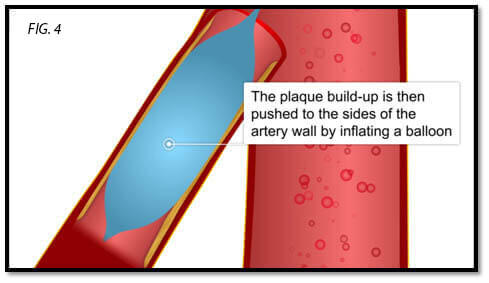
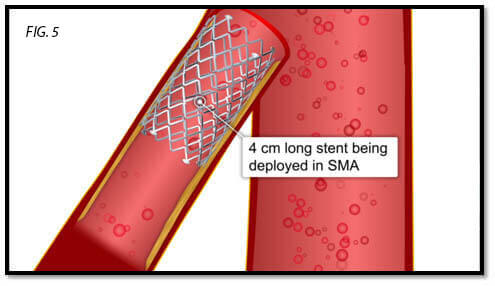
As the block was 10cm long, a balloon was inflated to push the plaque towards the walls of the vessels (Fig. 4).
Then a 4cm long stent was placed to keep the vessel open (Fig. 5).
The next day the patient’s pain had resolved and she enjoyed her morning cup of hot tea after a very long time. Slowly semisolid food was introduced and now she is managing it quite well. She also stopped having blood in the stools.
Watch MIOT Patient Story (procedure performed with Biplane CathLab)
Leave a reply